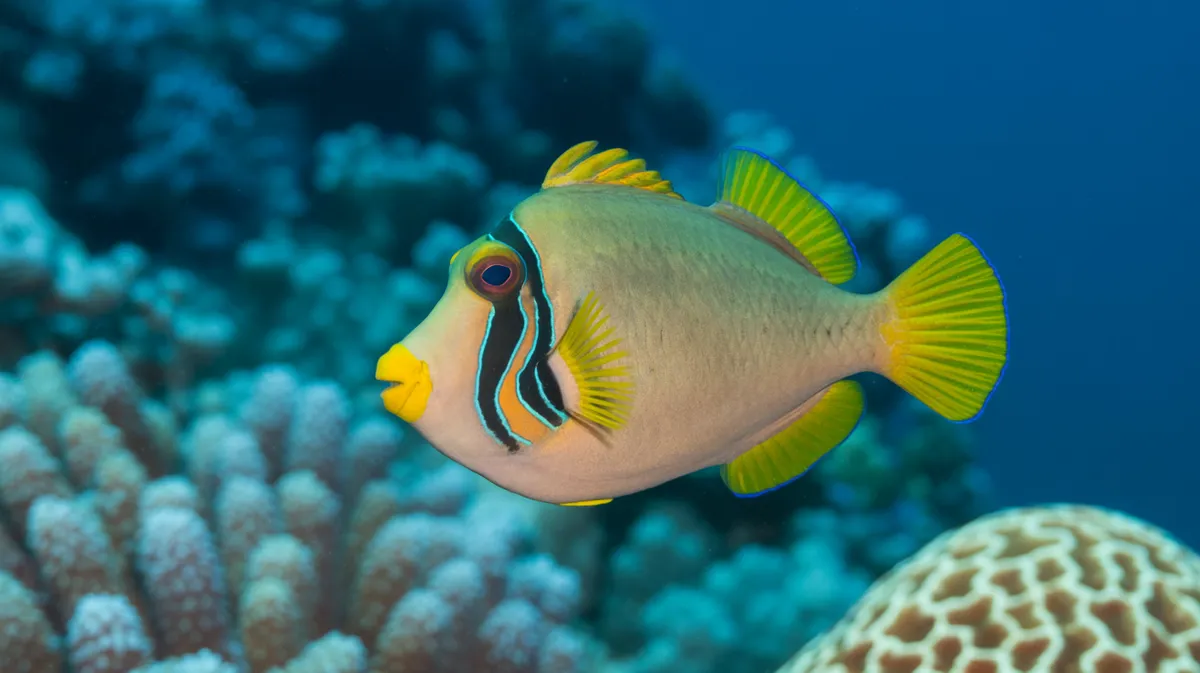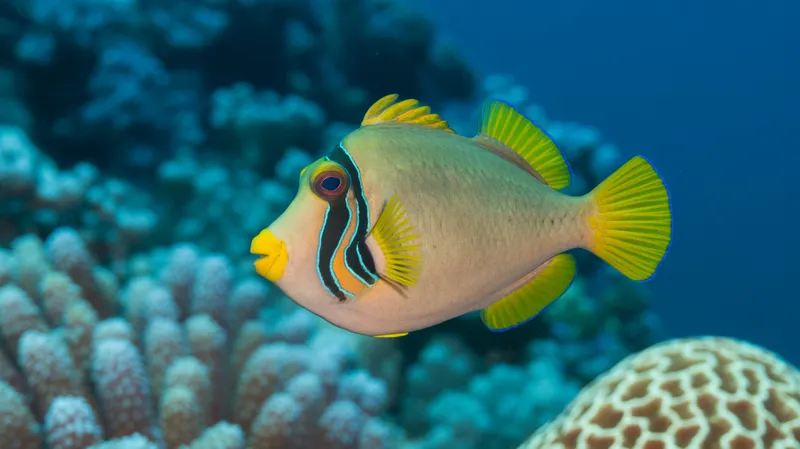
Harlequin Filefish
Oxymonacanthus longirostris

Meet the Harlequin Filefish
The Harlequin Filefish is a small, vibrantly colored marine fish known for its elongated snout and striking blue and orange patterning. It inhabits coral reefs in the Indo-Pacific region, where it relies heavily on live corals for both food and shelter. This species is highly specialized, feeding almost exclusively on Acropora coral polyps, making it sensitive to changes in reef health. Its slender body and cryptic coloration help it blend among coral branches, protecting it from predators.
Classification
Fish
Habitat
Coral reefs
Diet
Omnivore (primarily corallivore)
Lifespan
3-5 years
Conservation
Least Concern
Weight
10-20 grams
📖Fascinating Facts
Master of Camouflage
Harlequin Filefish are adept at matching the color and texture of their coral habitats, making them difficult for predators to spot.
Specialized Eater
Their unique, bristle-like teeth are perfectly adapted for picking at tiny coral polyps, their main food source.
Coral Dependency
This species has such a close relationship with Acropora corals that declines in coral reefs can significantly threaten its survival.
📋Detailed Description
The Harlequin Filefish (Oxymonacanthus longirostris) is a small, laterally compressed marine fish, typically reaching lengths of 6–10 cm, with a maximum recorded size of about 12 cm. Its body is adorned with a striking mosaic of blue spots and orange bands, providing effective camouflage among the branching corals it inhabits. The species is easily recognized by its elongated, tubular snout, which is highly specialized for extracting coral polyps from narrow crevices. The dorsal fin is equipped with a prominent, retractable spine, a characteristic feature of filefishes, which can be locked upright as a defense mechanism. The skin is rough and leathery, covered in tiny, non-overlapping scales called dermal denticles, providing additional protection against abrasion and predation. Harlequin Filefish exhibit a high degree of site fidelity, often remaining within a small home range centered around preferred coral colonies. Their cryptic coloration and slow, deliberate swimming style help them avoid detection by predators such as groupers and larger wrasses. Socially, they are usually observed in monogamous pairs, although small groups may form in areas of abundant coral. Their reliance on live Acropora corals for both food and shelter makes them particularly sensitive to coral health and reef disturbances. The species is diurnal, spending daylight hours actively foraging and retreating deeper into coral branches at night for protection.
💡 Did you know?
If stressed or removed from their natural coral habitat, Harlequin Filefish may rapidly lose their vibrant coloration and are unlikely to survive for long in captivity.
🔬Research & Sources
🎭Behavior & Social Structure
Harlequin Filefish display a highly specialized feeding behavior, using their elongated snouts and small, bristle-like teeth to nip individual polyps from Acropora coral branches. They feed almost exclusively on live coral polyps, with studies showing up to 97% of their diet consisting of Acropora species, making them obligate corallivores. Foraging is a slow, methodical process, with individuals or pairs moving carefully among coral branches to minimize disturbance and avoid attracting predators. Socially, they form stable monogamous pairs, often observed swimming and feeding together, maintaining close proximity and coordinated movements. Pair bonding is reinforced through mutual grooming and synchronized swimming. Harlequin Filefish are territorial, defending their chosen coral patch from conspecifics and other corallivorous fishes. Their daily routine involves periods of active feeding interspersed with resting or hiding within the coral structure, especially during periods of high predation risk or strong currents.
👶Reproduction & Life Cycle
Reproduction in Harlequin Filefish is characterized by strong pair bonds and coordinated spawning behavior. Breeding pairs engage in courtship displays involving color changes and synchronized swimming. Spawning typically occurs at dusk, with the female depositing adhesive eggs on the underside of coral branches or on dead coral substrate within their territory. The male guards the eggs, fanning them with his fins to ensure oxygenation and deter potential egg predators. Incubation lasts approximately 3–5 days, depending on water temperature. Upon hatching, the planktonic larvae are dispersed by currents and remain pelagic for several weeks before settling onto suitable coral habitat. There is little to no parental care after hatching, as is typical for most reef fishes. Breeding seasonality is not well documented, but spawning may peak during warmer months when planktonic food for larvae is abundant.
🛡️Adaptations & Survival
Oxymonacanthus longirostris exhibits several remarkable adaptations for its specialized corallivorous lifestyle. The elongated, tubular snout and small, fine teeth allow precise extraction of coral polyps without damaging the coral skeleton, minimizing energy expenditure and maximizing feeding efficiency. Their cryptic coloration and body shape provide effective camouflage among Acropora branches, reducing predation risk. The rough, sandpaper-like skin offers protection against abrasion from coral and deters some predators. The ability to lock the first dorsal spine upright serves as a deterrent to would-be predators, making the fish difficult to swallow or extract from coral crevices. Behavioral adaptations include monogamous pair bonding and territoriality, which help ensure access to a consistent food supply and increase reproductive success. Physiologically, Harlequin Filefish have evolved mechanisms to tolerate and detoxify the secondary metabolites produced by corals, which are toxic to most other fishes.
📚Research Sources
🎨Cultural Significance
The Harlequin Filefish holds limited direct cultural significance but is occasionally featured in public aquaria and marine photography due to its vivid coloration and unique appearance. In some regions, it is collected for the ornamental fish trade, although its specialized dietary needs make it a challenging species for home aquarists. The species serves as an indicator of coral reef health, and its presence is valued by conservationists and researchers studying coral–fish interactions. There are no known traditional uses, myths, or symbolic associations with this species in indigenous cultures.
🔬Recent Research & Discoveries
Recent research has focused on the ecological role of Harlequin Filefish as a specialist corallivore and its potential as a bioindicator for reef health. Studies have documented the species' dietary specialization, showing a strong preference for Acropora corals and a limited ability to switch to alternative food sources. Research on their chemical ecology has revealed that Harlequin Filefish can sequester and tolerate coral-derived toxins, possibly using these compounds for their own chemical defense. Ongoing studies are investigating the impacts of coral bleaching events on their population dynamics and reproductive success, as well as their potential resilience or vulnerability to rapid environmental changes. Advances in aquarium husbandry have provided new insights into their nutritional requirements and social behaviors, though successful long-term captive maintenance remains rare.
🎥Wildlife Videos

Harlequin Filefish Nature's Living Canvas Unveiled in a Kaleidoscope of Colors!
Harlequin Filefish Nature's Living Canvas Unveiled in a Kaleidoscope of Colors! Dive into the mesmerizing world of the Harlequin ...
Creature Canva

David Attenborough Presents: Whale Wisdom | Free Documentary Nature
David Attenborough Presents Whale Wisdom | Free Documentary Nature Whales have long been a profound mystery to us.
Free Documentary - Nature

Blue Whisper - The Fascinating World Beneath the Waves | Free Documentary Nature
Blue Whisper - The Fascinating World Beneath the Waves | Ocean Documentary Watch 'Adventure Ocean Quest: Discovering ...
Free Documentary - Nature

Wildlife Instincts | The Bizarre Underwater World of Noto Peninsula | Free Documentary Nature
Wildlife Instincts: The Bizarre Underwater World of Noto Peninsula | Wildlife Documentary Watch 'Wildlife Instincts: Mandrills ...
Free Documentary - Nature

Harlequin Filefish - Oxymonacanthus longirostris
Type: Fish Location: QLD, NSW, NT, WA Family: Filefishes Name: Harlequin Filefish Scientific Name: Oxymonacanthus ...
Strangefish

Harlequin File Fish
Harlequin File Fish swimming at Gab Gab. Taken August 22nd, 2017.
JD
🌍Habitat Information
The Harlequin Filefish typically inhabits Coral reefs environments. Harlequin Filefishs have adapted to their environments with specialized features and behaviors.
Primary Habitat:
Coral reefs
More detailed habitat information will be available soon.
🛡️Conservation Status
The Harlequin Filefish is currently classified as Least Concern. Conservation efforts are crucial for preserving this species for future generations.
Common Threats:
- 🏠Habitat loss and fragmentation
- 🌡️Climate change impacts
- 🎯Hunting and poaching
- 🏭Human-wildlife conflict
⚠️Threats & Conservation Challenges
The primary threat to Harlequin Filefish is the degradation and loss of coral reef habitats, particularly the decline of Acropora corals due to climate change, coral bleaching, ocean acidification, and destructive fishing practices. As obligate corallivores, they are highly sensitive to even minor reductions in coral cover, leading to local population declines in degraded reefs. Collection for the aquarium trade poses an additional, though localized, threat, as the species is difficult to maintain in captivity due to its specialized diet. Despite these challenges, the species is currently listed as Least Concern by the IUCN, owing to its wide distribution and presumed large population. However, ongoing declines in coral reef health could pose significant risks in the future, and population trends should be monitored closely.
🔬Scientific Classification
Scientific Name
Oxymonacanthus longirostris
Classification Hierarchy
🔍 About Taxonomic Classification
Taxonomic classification is a hierarchical system used by scientists to classify and organize living organisms based on shared characteristics and evolutionary relationships.
The system moves from broad categories (Kingdom) to increasingly specific ones, with each animal's scientific name typically consisting of its Genus and species.
📝Community Notes
Share your observations and insights about the Harlequin Filefish with our community of wildlife enthusiasts.
Join Our Community
Sign in to share your observations and connect with fellow wildlife enthusiasts.
Sign In to ContributeNo community notes yet
Be the first to share your observations about the Harlequin Filefish!
Explore Harlequin Filefish
Select a tab above to learn more about this amazing animal.
📸Photo Gallery
No photos available for this animal yet.
🌟Discover More Wildlife
Continue your journey of discovery with more fascinating animals from our database
